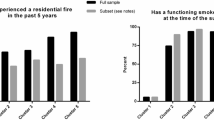Abstract
Whilst determinants for fire mortality and morbidity are well documented, the determinants of residential fires, regardless of outcome, are less known. This study aimed to investigate socio-demographic differences between households having experienced a fire and those who had not. Using a cross-sectional study design, a questionnaire was sent to a stratified sample (n = 20,000) of the Swedish population regarding if the household had experienced a fire during the past 5 years. Pearson’s χ2-test was used to test for bivariate associations between residential fires and socio-demographic covariates, and log-binomial regression models were applied to obtain covariate-adjusted risk ratios. Significant factors associated with an increased risk of residential fires were a high education level, being born outside of the Nordic countries and having children 6–12 years living at home. A significant decreased risk was observed amongst elderly and those living in rented, multi-family houses. There seems to be a lack of agreement between determinants for fires and for fire mortality. This would indicate that the risk of fire mortality per residential fire is greatly increased for certain groups and that the increased risk of fire mortality is not due to a more common occurrence of fires.
Similar content being viewed by others
References
WHO (2004) The World Health Report
Statistics Sweden (2014) Living conditions in Sweden. Available at: http://www.ssd.scb.se/databaser/. Accessed 10/12, 2014
Harrami O, McIntyre C (2016) Fire and fire protection in homes and public buildings: an analysis of Swedish fire statistics and fire protection strategies. 1/06
Berglöf J (2008) Bränders Samhällsekonomiska Kostnader (in Swedish). 2008:6A
Marshall SW, Runyan CW, Bangdiwala SI, Linzer MA, Sacks JJ, Butts JD (1998) Fatal residential fires: who dies and who survives? JAMA 279(20):1633–1637
Duncanson M, Woodward A, Reid P (2002) Socioeconomic deprivation and fatal unintentional domestic fire incidents in New Zealand 1993–1998. Fire Saf J 37(2):165–179
Jennings CR (1999) Socioeconomic characteristics and their relationship to fire incidence: a review of the literature. Fire Technol 35(1):7–34
Holborn P, Nolan P, Golt J (2003) An analysis of fatal unintentional dwelling fires investigated by London Fire Brigade between 1996 and 2000. Fire Saf J 38(1):1–42
Shai D, Lupinacci P (2003) Fire fatalities among children: an analysis across Philadelphia’s census tracts. Public Health Rep 118(2):115–126(2003)
Runyan CW, Bangdiwala SI, Linzer MA, Sacks JJ, Butts J (1992) Risk factors for fatal residential fires. N Engl J Med 327(12):859–863
Chandler S, Chapman A, Hollington S (1984) Fire incidence, housing and social conditions―the urban situation in Britain. Fire Prev 172:15–20.
Greene MA (2012) Comparison of the characteristics of fire and non-fire households in the 2004–2005 survey of fire department-attended and unattended fires. Inj Prev 18(3):170–175
Fires in the Home (2003) Findings from the 2001/02 British Crime Survey
Fires in the Home (2004) Findings from the 2002/03 British Crime Survey
Fires in the Home (2006) Findings from the 2004/05 Survey of English Housing
Audits and Survey Inc. (1985) 1984 national sample survey of unreported residential fires: final technical report prepared
Ludvigsson JF, Otterblad-Olausson P, Pettersson BU, Ekbom A (2009) The Swedish personal identity number: possibilities and pitfalls in healthcare and medical research. Eur J Epidemiol 24(11):659–667
UNESCO (1997) International Standard Classification of Education-ISCED 1997. November 1997. UNESCO
Barros AJ, Hirakata VN (2003) Alternatives for logistic regression in cross-sectional studies: an empirical comparison of models that directly estimate the prevalence ratio. BMC Med Res Methodol 20(3):21
Lindstrom M, Sundquist J (2002) Ethnic differences in daily smoking in Malmo, Sweden. Varying influence of psychosocial and economic factors. Eur J Public Health 12(4):287–294
Carlsson A, Uden G, Hakansson A, Karlsson ED (2006) Burn injuries in small children, a population-based study in Sweden. J Clin Nurs 15(2):129–134
Klein JJ, Mondozzi MA, Andrews DA (2008) The need for a juvenile fire setting database. J Burn Care Res 29(6):955–958
Hyresbostadsutredningen (2012) Rental housing—from a dwindling right to an option for many. SOU 2012:88
Hannon L, Shai D (2003) The truly disadvantaged and the structural covariates of fire death rates. Soc Sci J 40(1):129–136
Warda L, Tenenbein M, Moffatt ME (1999) House fire injury prevention update. Part I. A review of risk factors for fatal and non-fatal house fire injury. Inj Prev 5(2):145–150
Petridou E, Trichopoulos D, Mera E, Papadatos Y, Papazoglou K, Marantos A et al (1998) Risk factors for childhood burn injuries: a case-control study from Greece. Burns 24(2):123–128
Shai D (2006) Income, housing, and fire injuries: a census tract analysis. Public Health Rep 121(2):149–154
Cumming RG, Klineberg RJ (1994) A study of the reproducibility of long-term recall in the elderly. Epidemiology 5(1):116–119
Galea S, Tracy M (2007) Participation rates in epidemiologic studies. Ann Epidemiol 17(9):643–653
Gillham B (2008) Developing a questionnaire. Bloomsbury Publishing
Acknowledgments
The authors’ gratefully thank the Swedish Civil Contingencies Agency (MSB) for financial support (Grant number 2014-5283). The funding source had no role in the design of the study, the analysis and interpretation of the data or the writing of, nor the decision to publish, the manuscript.
Author information
Authors and Affiliations
Corresponding author
Rights and permissions
About this article
Cite this article
Nilson, F., Bonander, C. & Jonsson, A. Differences in Determinants Amongst Individuals Reporting Residential Fires in Sweden: Results from a Cross-Sectional Study. Fire Technol 51, 615–626 (2015). https://doi.org/10.1007/s10694-015-0459-0
Received:
Accepted:
Published:
Issue Date:
DOI: https://doi.org/10.1007/s10694-015-0459-0




